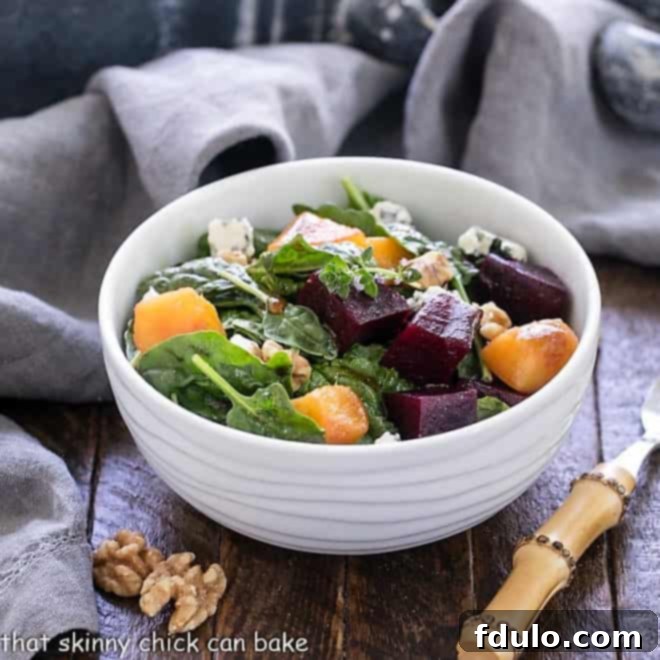As the days grow long and the sun shines bright, our kitchens yearn for recipes that capture the essence of the season. This Peach and Beet Salad with Thyme Vinaigrette delivers just that – a vibrant, flavorful ode to summer, bursting with fresh produce and delightful textures. Imagine succulent, sweet peaches perfectly complementing the earthy richness of tender beets, all brought together by a zesty, aromatic thyme dressing. It’s more than just a salad; it’s a culinary experience that refreshes the palate and elevates any meal, making it an ideal choice for warm-weather gatherings or a light, nutritious lunch.
This exquisite Cold Beet Salad is designed for simplicity and maximum flavor. It starts with a clever, hassle-free method of cooking beets in the microwave, ensuring they are perfectly tender without heating up your kitchen. Once chilled, these vibrant root vegetables are transformed into an amazing base for a side dish or a light main. The thoughtful addition of juicy peaches, creamy blue cheese, crunchy walnuts, and a distinctive thyme-infused vinaigrette elevates this to a truly unique and irresistible salad that will impress both connoisseurs and casual diners alike. Prepare to make this your go-to summer salad recipe!
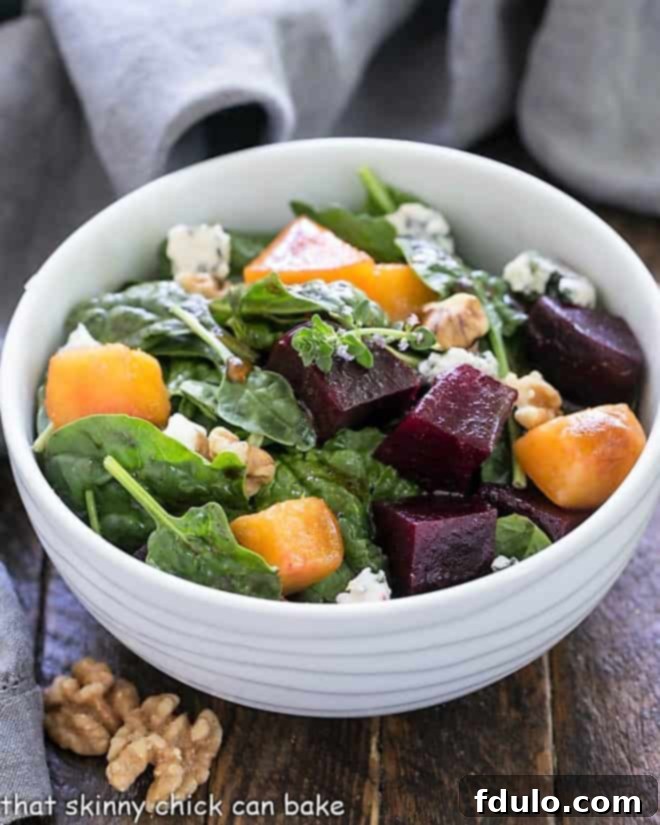
Why This Peach and Beet Salad Will Become Your Summer Favorite
In the realm of summer salads, this Peach and Beet Salad with Thyme Vinaigrette stands out. It’s not just another recipe; it’s a revelation of flavors and convenience, perfectly suited for the season. Here’s why you absolutely need to add this vibrant dish to your culinary repertoire:
- Effortless Beet Preparation: Forget the fuss of boiling or the lengthy process of roasting beets! This recipe champions a super easy microwave method that yields perfectly tender beets in a fraction of the time. This means you can whip up this elegant salad without turning on your oven or stove, keeping your kitchen cool and making it truly perfect for even the hottest summer days. The simplicity of this technique is a game-changer for beet lovers.
- A Symphony of Flavors: The combination of sweet, succulent peaches and earthy, slightly savory beets is nothing short of culinary magic. These two seemingly disparate ingredients marry beautifully, creating a harmonious balance that is both refreshing and deeply satisfying. This pairing, enhanced by the creamy tang of blue cheese and the crunch of toasted walnuts, offers an exciting textural and flavor contrast in every bite, transforming a simple side into a memorable dish.
- Aromatic Thyme Vinaigrette: What truly sets this salad apart is its homemade thyme vinaigrette. Fresh thyme infuses the dressing with an aromatic, herbaceous note that brightens and elevates all the other ingredients. The zesty blend of balsamic vinegar, olive oil, Dijon mustard, and a hint of honey creates a dressing that is light yet impactful, tying together the diverse flavors of the peaches, beets, cheese, and walnuts into a cohesive and incredibly delicious experience. It’s a burst of fresh herbs that makes every forkful an absolute delight.
- Perfect for Any Occasion: Whether you’re hosting a backyard barbecue, looking for a sophisticated potluck contribution, or simply craving a healthy and satisfying meal at home, this Cold Beet Salad fits the bill. Its stunning visual appeal and complex flavor profile make it a showstopper, while its ease of preparation makes it a practical choice for busy days.
Before diving into the quick and simple cooking technique for the beets, let’s explore a little more about this fascinating root vegetable. The journey to perfecting this salad led me back to a fantastic method for preparing beets I’d learned years ago – all accomplished in the microwave! This technique preserves their vibrant color and essential nutrients while drastically cutting down on prep time. But first, let’s deepen our understanding of beets, their unique characteristics, and their place in a healthy diet.
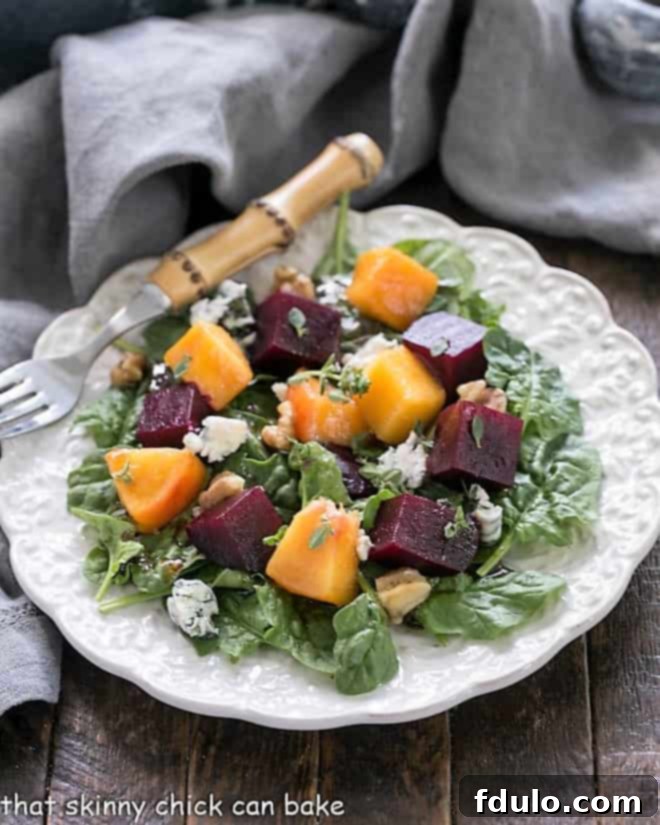
All About Beets: History, Varieties, and Health Benefits
Beets, scientifically known as Beta vulgaris, are not just a visually stunning vegetable; they boast a rich history and an impressive nutritional profile. Originating from the wild “sea beet” found in coastal areas, beets have been cultivated for thousands of years, initially for their leaves and later for their nutritious roots. Ancient Romans were among the first to widely cultivate beets, appreciating them for both culinary and medicinal purposes.
Today, beets come in a delightful array of colors and shapes. While the deep red beet is most common, you can also find golden beets, which offer a milder, sweeter flavor and don’t “bleed” their color, making them excellent for salads where color control is desired. Chioggia beets, also known as candy stripe beets, reveal beautiful concentric rings of red and white when sliced, adding a playful touch to any dish. Each variety brings its own subtle nuances in taste and texture, allowing for creative exploration in the kitchen.
Beyond their vibrant hues and earthy flavor, beets are nutritional powerhouses. They are low in calories, high in fiber, and packed with essential vitamins and minerals, including Vitamin C, Folate (Vitamin B9), Vitamin B6, Iron, Potassium, and Magnesium. These nutrients contribute to a range of health benefits:
- Blood Pressure Regulation: Beets are rich in nitrates, which the body converts into nitric oxide. Nitric oxide helps to relax and dilate blood vessels, leading to a temporary but significant decrease in blood pressure, promoting cardiovascular health.
- Enhanced Digestion: The high fiber content in beets supports a healthy digestive system, aiding in regular bowel movements and preventing constipation. This also contributes to satiety, helping with weight management.
- Brain Health: The nitrates in beets may also improve blood flow to the brain, potentially enhancing cognitive function and reducing the risk of age-related cognitive decline.
- Anti-inflammatory Properties: Beets contain betalains, powerful antioxidants and anti-inflammatory compounds responsible for their distinctive red color. These compounds help protect cells from damage and reduce inflammation throughout the body.
- Athletic Performance: Many athletes consume beet juice to boost stamina and improve performance, thanks to the nitrates that enhance oxygen utilization during exercise.
Incorporating beets into your diet, whether through this delicious Peach and Beet Salad or other dishes, is a fantastic way to enjoy their unique flavor while reaping their numerous health benefits.
Frequently Asked Questions About Beets and Beet Salads
It’s a common experience for some, including my discerning husband who can detect beets even in a chocolate cake! The distinct earthy flavor that some people perceive as “dirt-like” is due to a natural compound called geosmin. Geosmin is an organic compound produced by certain microorganisms in the soil and is what gives freshly plowed earth its characteristic aroma. Interestingly, it’s also found in other foods like lettuce, mushrooms, spinach, and even some fish, such as catfish. Our individual sensitivity to geosmin varies; some people are highly attuned to it, while others barely notice it or find it pleasant. While this earthy note is a hallmark of beets, selecting younger, smaller beets often results in a milder flavor, and proper cooking methods can also help reduce its intensity, allowing the inherent sweetness to shine through.
This phenomenon, scientifically known as beeturia, occurs when the red pigments in beets, called betalains, pass through the body and are excreted in urine or stool without being fully broken down. It’s estimated that 10-14% of people who consume beets will experience this vibrant side effect. Betalains are powerful antioxidants and are responsible for the beautiful crimson hue of red beets. The occurrence of beeturia is often tied to genetics, stomach acid levels, and the amount of beets consumed. While it can be alarming to see pink or red urine, beeturia is completely harmless and simply an indication that your body is processing these natural pigments. It’s also a good reminder of the rich antioxidant content you’re consuming!
Beets are incredibly versatile and can be cooked in various ways: roasting, boiling, or microwaving. For salads, especially during hot summer months, convenience and speed are key. While I often enjoy the deep, caramelized flavor of roasted beets (usually by wrapping them in foil and roasting until tender), the microwave method is a revelation for its ease and ability to keep your kitchen cool. To microwave beets for this salad, simply wash and trim the beets, place them in a microwave-safe bowl with about 1-2 inches of water, cover the bowl tightly with plastic wrap (or a microwave-safe lid), and microwave on high for approximately 15-20 minutes, or until fork-tender. Cooking time will vary based on beet size and microwave wattage. Once cooked, allow them to cool slightly, then the skins will slip off easily. Cube them, and they are perfectly ready for your Cold Beet Salad. This method not only saves time but also preserves their vibrant color and fresh taste, which is ideal for a refreshing salad.
Absolutely! Beets are indeed a nutritional powerhouse. They are wonderfully low in calories and exceptionally high in fiber, making them excellent for digestive health and satiety. Beyond that, beets are rich in a host of essential vitamins and minerals. They contain Vitamin C, which is vital for immune function and skin health; Folate (B9), crucial for cell growth and function; Vitamin B6, important for brain development and nerve function; Iron, essential for oxygen transport in the blood; Potassium, which supports heart health and blood pressure; and Magnesium, involved in over 300 biochemical reactions in the body. As highlighted by Healthline, beets are particularly noted for their ability to temporarily decrease blood pressure due to their nitrate content, aid digestion through their fiber, and potentially promote brain health by increasing blood flow to the brain. Their potent antioxidant and anti-inflammatory properties, attributed to betalains, further contribute to overall well-being and cellular protection.
Beets have a distinct earthy sweetness that harmonizes beautifully with a variety of cheeses, often those with a contrasting creamy texture or a tangy, salty flavor. My two absolute go-to choices for a beet salad are blue cheese and goat cheese. Blue cheese, with its pungent, salty, and creamy notes, creates a wonderful contrast that cuts through the earthiness of the beets, adding a sophisticated depth of flavor. Goat cheese, on the other hand, offers a milder tang and a wonderfully crumbly, yet creamy texture that complements the beets without overpowering them. Both add a delightful richness and complexity. Other excellent options include salty feta cheese, which provides a briny kick; grated Parmesan, offering a nutty, umami depth; and even fresh ricotta or a mild chèvre for a softer, creamier mouthfeel. Experimenting with different cheeses can significantly alter the character of your Peach and Beet Salad, allowing you to tailor it to your preference.
The versatility of beets extends to their compatibility with various dressings. A simple vinaigrette is almost always a delicious choice, providing the necessary acidity to brighten the earthy and sweet flavors of beets. For this particular Peach and Beet Salad, a thyme vinaigrette is exceptional, infusing a fresh, herbaceous aroma that perfectly complements both the peaches and beets. Beyond vinaigrettes, creamy dressings also work wonderfully. Options like a classic ranch dressing or a tangy blue cheese dressing (especially if you’re using blue cheese in the salad) can provide a rich, smooth counterpoint. A light buttermilk dressing can also offer a refreshing creaminess. When choosing a dressing, consider elements like herbs (dill, mint, parsley are great with beets), citrus (lemon or orange zest can add a lovely zing), and a touch of sweetness (honey or maple syrup) to balance the beets’ natural flavors.
Absolutely! This salad is fantastic for meal prep as several components can be prepared in advance, saving you time when you’re ready to serve. You can cook, cool, peel, and cube your beets up to 2-3 days ahead of time and store them in an airtight container in the refrigerator. The thyme vinaigrette can also be made a day or two in advance and stored in a sealed jar in the fridge; just give it a good shake before drizzling. Toasting and chopping the walnuts can also be done ahead and stored at room temperature. For the peaches, it’s best to peel and cube them closer to serving time to maintain their freshness and prevent browning, though a light toss in lemon juice can help. The baby spinach should always be added just before serving to ensure it remains crisp and fresh. This strategic prep makes assembling the final salad quick and stress-free.
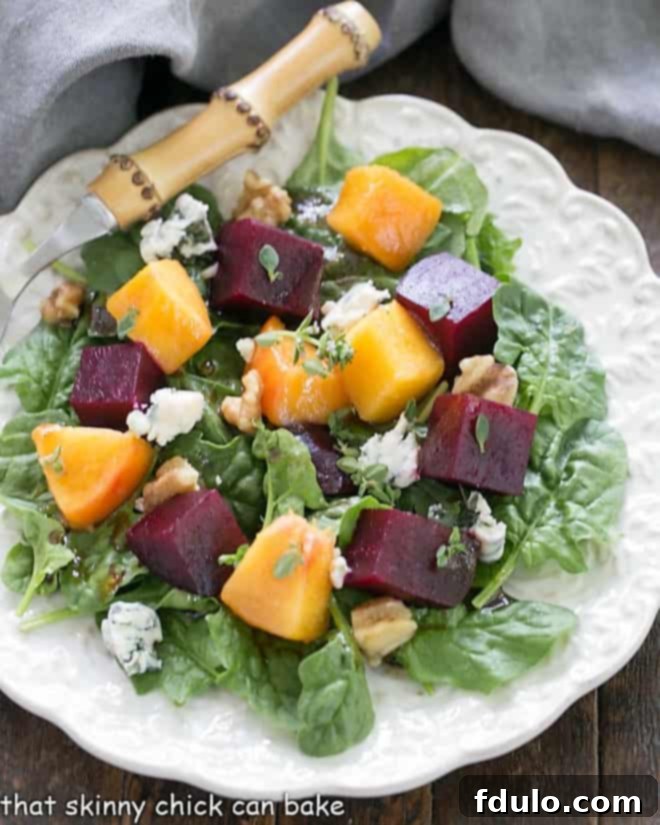
How to Make a Refreshing Cold Beet and Peach Salad
Crafting this delightful Cold Beet Salad is a straightforward process, made even easier with our special tips. Follow these steps to create a show-stopping dish that’s perfect for any summer occasion:
- Prepare and Chill Your Beets: Start by cooking your beets. As discussed, the microwave method is ideal for speed and convenience. Wash 3 small to medium beets thoroughly and trim off the greens, leaving about an inch of stem attached to prevent excessive bleeding. Place them in a microwave-safe bowl with about 1-2 inches of water, cover tightly with plastic wrap or a lid, and microwave on high for 15-20 minutes, or until they are easily pierced with a fork. Once cooked, carefully remove from the microwave, let them cool down completely, and then gently peel off the skins (they should slip off easily under cool running water or with a paring knife). Finally, cut them into bite-sized cubes. This step can be done a day in advance and the cubed beets stored in the refrigerator.
- Perfectly Peel and Cube Peaches: For the freshest taste and texture, choose ripe but firm peaches. To effortlessly peel them, score a small ‘X’ on the non-stem end of each peach, just through the skin. Carefully drop the peaches into a pan of boiling water for 15-30 seconds. Watch closely; as soon as you see the skin start to pull away from the fruit, immediately transfer them to a bowl of ice water to stop the cooking process. Once cool enough to handle, the skin will slide off easily with your fingers or a small paring knife. Pit and cube your peeled peaches.
- Toast and Chop Walnuts for Enhanced Flavor: This crucial step brings out the natural oils and deepens the flavor of the walnuts, adding an irresistible crunch to your salad. Spread ⅓ cup of walnuts in a single layer on a baking sheet or in a dry skillet. If using an oven, toast at 350°F (175°C) for 5-7 minutes; if using a skillet, toast over medium heat for 3-5 minutes, stirring frequently, until fragrant and lightly golden. Be careful not to burn them! Let them cool completely, then coarsely chop them.
- Whip Up the Aromatic Thyme Vinaigrette: In a small bowl, combine 3 tablespoons of aged balsamic vinegar, 1 teaspoon of Dijon mustard, 1 teaspoon of honey, ½ teaspoon of fresh thyme leaves (finely chopped), and salt and pepper to taste. Whisk these ingredients together until well combined. Slowly drizzle in 3 tablespoons of good quality olive oil while continuously whisking. This slow addition helps to emulsify the dressing, creating a smooth, cohesive vinaigrette that coats the salad beautifully.
- Assemble Your Vibrant Salad: Begin by arranging 3-5 ounces of fresh baby spinach on individual plates for a more elegant presentation, or place it in a large serving bowl if serving family-style. Artfully top the spinach with the prepared cubed beets, fresh peach cubes, toasted chopped walnuts, and ⅓ cup of crumbled blue cheese (or goat cheese, if preferred).
- Dress and Serve Immediately: Just before serving, drizzle the assembled salad generously with your homemade thyme vinaigrette. If using a large serving bowl, gently toss the salad to ensure all ingredients are evenly coated with the dressing. Serve immediately to enjoy the freshest flavors and crispest textures of this exceptional Peach and Beet Salad with Thyme Vinaigrette.
Variations and Serving Suggestions
This Peach and Beet Salad is wonderfully versatile, allowing for creative adaptations to suit your taste or what you have on hand. Don’t hesitate to experiment with these ideas:
- Nut Substitutions: If walnuts aren’t your favorite, pecans, almonds, or even pistachios can offer a delicious alternative crunch. Toasting any nut will enhance its flavor.
- Cheese Choices: While blue cheese offers a bold, creamy contrast, creamy goat cheese provides a tangier, milder profile that pairs beautifully with beets and peaches. For a saltier kick, try crumbled feta. A sprinkle of shaved Parmesan can also add a savory depth.
- Herb Alternatives: Fresh mint or basil can be lovely substitutes for thyme in the vinaigrette or sprinkled directly into the salad, offering a different aromatic dimension.
- Add Protein: To transform this into a heartier main course, consider adding grilled chicken, pan-seared salmon, or a handful of chickpeas for a vegetarian option.
- Leafy Green Base: While baby spinach is fantastic, mixed greens, arugula (for a peppery bite), or even tender butter lettuce can be used as the base.
- Extra Sweetness/Tang: A few fresh raspberries or blackberries can complement the peaches beautifully, adding an extra burst of color and fruitiness. A squeeze of fresh orange or lemon juice over the peaches just before serving can also enhance their flavor.
Serve this salad as a refreshing appetizer, a light lunch, or a stunning side dish to grilled meats, poultry, or fish. It’s particularly well-suited for summer picnics, barbecues, and outdoor dining, thanks to its vibrant colors and cool, crisp nature.
Storage Tips for Your Peach and Beet Salad
To ensure your Peach and Beet Salad with Thyme Vinaigrette remains fresh and delicious, proper storage is key, especially if you have leftovers or are preparing it in advance:
- Undressed Salad: If you anticipate having leftovers or are preparing the salad ahead, it’s always best to store the components separately. Keep the cooked and cubed beets in an airtight container in the refrigerator for up to 3 days. Similarly, cubed peaches, walnuts, blue cheese, and spinach should be stored in separate airtight containers. This prevents the spinach from wilting and the peaches from softening too much or browning.
- Vinaigrette: The thyme vinaigrette can be made up to 3-4 days in advance. Store it in a tightly sealed jar in the refrigerator. Before using, allow it to come to room temperature for a few minutes and give it a good shake or whisk to re-emulsify any separated ingredients.
- Assembled Salad: Once the salad has been dressed, it is best enjoyed immediately. The vinaigrette will cause the spinach to wilt and the peaches to become softer over time. If you do have dressed leftovers, they can be stored in an airtight container in the refrigerator for up to 1 day, though the texture will not be as crisp as freshly made.
By following these simple storage guidelines, you can enjoy the fresh, vibrant flavors of this delightful summer salad whenever the craving strikes!
You May Also Like These Salad Recipes:
- Easy Greek Salad from Saving Room for Dessert
- Strawberry Bacon Brie Salad
- Guacamole Salad
- Gazpacho Spinach Salad
- Cold Beet Salad Recipe
- More of the Best Salad Recipes
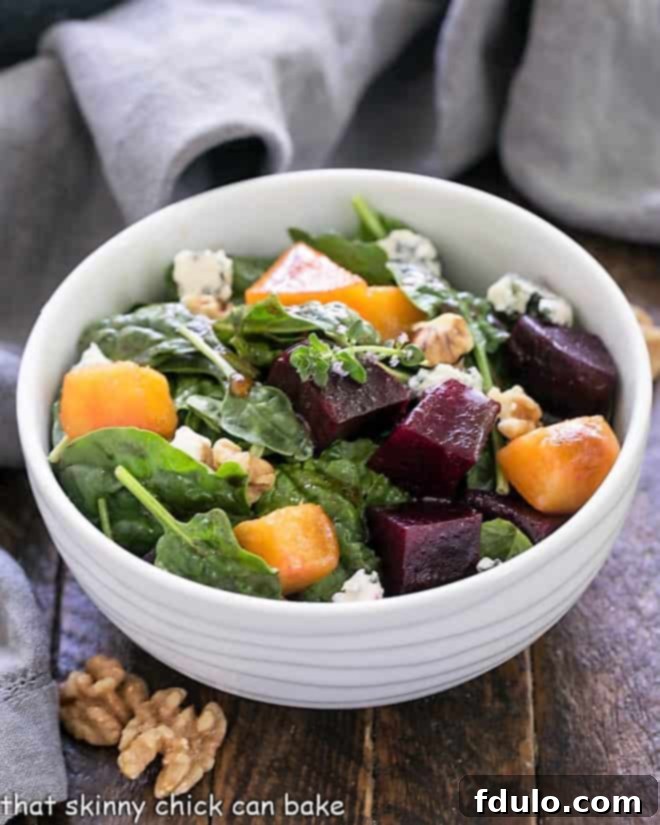
Peach and Beet Salad Recipe
15 minutes
15 minutes
6 servings
An unusual and refreshing summer salad combining fresh, sweet peaches with tender, earthy beets, crisp spinach, crunchy walnuts, and savory blue cheese, all tossed in a zesty homemade thyme vinaigrette.
User Rating: 5 out of 5 stars based on 36 ratings.
Ingredients
Salad
- 3 small to medium beets, cooked, peeled and cut into cubes
- 1 fresh peach, pitted, peeled and cubed
- 3-5 ounces fresh baby spinach
- ⅓ cup crumbled blue cheese (or more to taste)
- ⅓ cup walnuts, toasted and chopped
Vinaigrette
- 3 tablespoons aged balsamic vinegar
- 3 tablespoons olive oil
- 1 teaspoon Dijon mustard
- 1 teaspoon honey
- ½ teaspoon fresh thyme leaves
- Salt and pepper to taste
Instructions
- Place the spinach in a large salad bowl or divide it between individual salad plates.
- Top with beets, peaches, blue cheese, and walnuts.
- Make the beet salad dressing by whisking together the vinegar, mustard, honey, thyme, salt, and pepper in a small bowl.
- Slowly drizzle in the olive oil while whisking continuously until the mixture is well combined and emulsified.
- Drizzle the assembled salad or individual salads generously with the vinaigrette. For a large salad, toss gently right before serving to ensure all ingredients are coated.
Notes
You can replace walnuts with pecans for a slightly different nutty flavor and texture.
If you’d prefer a milder, tangier cheese, goat cheese will work exceptionally well in this salad as an alternative to blue cheese.
Recommended Products
As an Amazon Associate and member of other affiliate programs, I earn from qualifying purchases.
- OXO Good Grips 11-Inch Better Balloon Whisk
- 3 Pyrex Mixing Bowls
Nutrition Information:
Yield:
6
Serving Size:
1
Amount Per Serving:
Calories: 166Total Fat: 13gSaturated Fat: 3gTrans Fat: 0gUnsaturated Fat: 10gCholesterol: 6mgSodium: 221mgCarbohydrates: 10gFiber: 3gSugar: 6gProtein: 5g
Thatskinnychickcanbake.com occasionally offers nutritional information for recipes contained on this site. This information is provided as a courtesy and is an estimate only. This information comes from online calculators. Although thatskinnychickcanbake.com attempts to provide accurate nutritional information, these figures are only estimates. Varying factors such as product types or brands purchased can change the nutritional information in any given recipe. Also, many recipes on thatskinnychickcanbake.com recommend toppings, which may or may not be listed as optional and nutritional information for these added toppings is not listed. Other factors may change the nutritional information such as when the salt amount is listed “to taste,” it is not calculated into the recipe as the amount will vary. Also, different online calculators can provide different results. To obtain the most accurate representation of the nutritional information in any given recipe, you should calculate the nutritional information with the actual ingredients used in your recipe. You are solely responsible for ensuring that any nutritional information obtained is accurate.
HOW MUCH DID YOU LOVE THIS RECIPE?
Please leave a comment on the blog or share a photo on Pinterest
